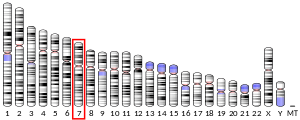AUTS2
AUTS2, activator of transcription and developmental regulator is a protein that in humans is encoded by the AUTS2 gene. [5]
Function
This gene has been implicated in neurodevelopment and as a candidate gene for numerous neurological disorders, including autism spectrum disorders, intellectual disability, and developmental delay. Mutations in this gene have also been associated with non-neurological disorders, such as acute lymphoblastic leukemia, aging of the skin, early-onset androgenetic alopecia, and certain cancers. Alternative splicing results in multiple transcript variants encoding different isoforms.
References
- 1 2 3 GRCh38: Ensembl release 89: ENSG00000158321 - Ensembl, May 2017
- 1 2 3 GRCm38: Ensembl release 89: ENSMUSG00000029673 - Ensembl, May 2017
- ↑ "Human PubMed Reference:".
- ↑ "Mouse PubMed Reference:".
- ↑ "Entrez Gene: AUTS2, activator of transcription and developmental regulator". Retrieved 2017-09-12.
Further reading
- Gratacòs M, Costas J, de Cid R, Bayés M, González JR, Baca-García E, de Diego Y, Fernández-Aranda F, Fernández-Piqueras J, Guitart M, Martín-Santos R, Martorell L, Menchón JM, Roca M, Sáiz-Ruiz J, Sanjuán J, Torrens M, Urretavizcaya M, Valero J, Vilella E, Estivill X, Carracedo A (2009). "Identification of new putative susceptibility genes for several psychiatric disorders by association analysis of regulatory and non-synonymous SNPs of 306 genes involved in neurotransmission and neurodevelopment". Am. J. Med. Genet. B Neuropsychiatr. Genet. 150B (6): 808–16. doi:10.1002/ajmg.b.30902. PMID 19086053.
- Trynka G, Zhernakova A, Romanos J, Franke L, Hunt KA, Turner G, Bruinenberg M, Heap GA, Platteel M, Ryan AW, de Kovel C, Holmes GK, Howdle PD, Walters JR, Sanders DS, Mulder CJ, Mearin ML, Verbeek WH, Trimble V, Stevens FM, Kelleher D, Barisani D, Bardella MT, McManus R, van Heel DA, Wijmenga C (2009). "Coeliac disease-associated risk variants in TNFAIP3 and REL implicate altered NF-kappaB signalling". Gut. 58 (8): 1078–83. doi:10.1136/gut.2008.169052. PMID 19240061.
- Elia J, Gai X, Xie HM, Perin JC, Geiger E, Glessner JT, D'arcy M, deBerardinis R, Frackelton E, Kim C, Lantieri F, Muganga BM, Wang L, Takeda T, Rappaport EF, Grant SF, Berrettini W, Devoto M, Shaikh TH, Hakonarson H, White PS (2010). "Rare structural variants found in attention-deficit hyperactivity disorder are preferentially associated with neurodevelopmental genes". Mol. Psychiatry. 15 (6): 637–46. doi:10.1038/mp.2009.57. PMC 2877197. PMID 19546859.
- Hamshere ML, Green EK, Jones IR, Jones L, Moskvina V, Kirov G, Grozeva D, Nikolov I, Vukcevic D, Caesar S, Gordon-Smith K, Fraser C, Russell E, Breen G, St Clair D, Collier DA, Young AH, Ferrier IN, Farmer A, McGuffin P, Holmans PA, Owen MJ, O'Donovan MC, Craddock N (2009). "Genetic utility of broadly defined bipolar schizoaffective disorder as a diagnostic concept". Br J Psychiatry. 195 (1): 23–9. doi:10.1192/bjp.bp.108.061424. PMC 2802523. PMID 19567891.
- Talmud PJ, Drenos F, Shah S, Shah T, Palmen J, Verzilli C, Gaunt TR, Pallas J, Lovering R, Li K, Casas JP, Sofat R, Kumari M, Rodriguez S, Johnson T, Newhouse SJ, Dominiczak A, Samani NJ, Caulfield M, Sever P, Stanton A, Shields DC, Padmanabhan S, Melander O, Hastie C, Delles C, Ebrahim S, Marmot MG, Smith GD, Lawlor DA, Munroe PB, Day IN, Kivimaki M, Whittaker J, Humphries SE, Hingorani AD (2009). "Gene-centric association signals for lipids and apolipoproteins identified via the HumanCVD BeadChip". Am. J. Hum. Genet. 85 (5): 628–42. doi:10.1016/j.ajhg.2009.10.014. PMC 2775832. PMID 19913121.
- Rose JE, Behm FM, Drgon T, Johnson C, Uhl GR (2010). "Personalized smoking cessation: interactions between nicotine dose, dependence and quit-success genotype score". Mol. Med. 16 (7–8): 247–53. doi:10.2119/molmed.2009.00159. PMC 2896464. PMID 20379614.
- Saus E, Brunet A, Armengol L, Alonso P, Crespo JM, Fernández-Aranda F, Guitart M, Martín-Santos R, Menchón JM, Navinés R, Soria V, Torrens M, Urretavizcaya M, Vallès V, Gratacòs M, Estivill X (2010). "Comprehensive copy number variant (CNV) analysis of neuronal pathways genes in psychiatric disorders identifies rare variants within patients". J Psychiatr Res. 44 (14): 971–8. doi:10.1016/j.jpsychires.2010.03.007. PMID 20398908.
- Bailey SD, Xie C, Do R, Montpetit A, Diaz R, Mohan V, Keavney B, Yusuf S, Gerstein HC, Engert JC, Anand S (2010). "Variation at the NFATC2 locus increases the risk of thiazolidinedione-induced edema in the Diabetes REduction Assessment with ramipril and rosiglitazone Medication (DREAM) study". Diabetes Care. 33 (10): 2250–3. doi:10.2337/dc10-0452. PMC 2945168. PMID 20628086.
- Huang XL, Zou YS, Maher TA, Newton S, Milunsky JM (2010). "A de novo balanced translocation breakpoint truncating the autism susceptibility candidate 2 (AUTS2) gene in a patient with autism". Am. J. Med. Genet. A. 152A (8): 2112–4. doi:10.1002/ajmg.a.33497. PMID 20635338.
This article incorporates text from the United States National Library of Medicine, which is in the public domain.
This article is issued from
Wikipedia.
The text is licensed under Creative Commons - Attribution - Sharealike.
Additional terms may apply for the media files.



